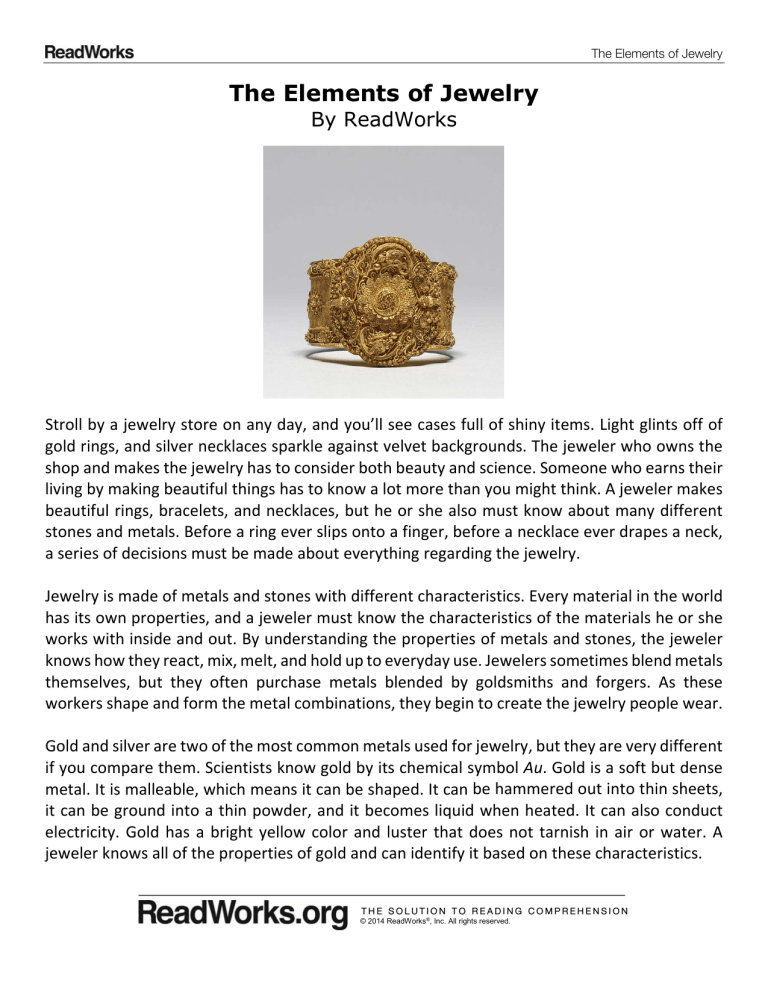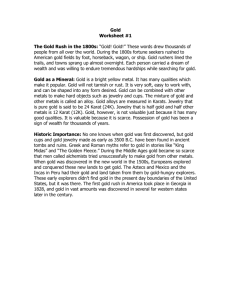Close Reading- The elements of jewelry
advertisement

The Elements of Jewelry The Elements of Jewelry By ReadWorks Stroll by a jewelry store on any day, and you’ll see cases full of shiny items. Light glints off of gold rings, and silver necklaces sparkle against velvet backgrounds. The jeweler who owns the shop and makes the jewelry has to consider both beauty and science. Someone who earns their living by making beautiful things has to know a lot more than you might think. A jeweler makes beautiful rings, bracelets, and necklaces, but he or she also must know about many different stones and metals. Before a ring ever slips onto a finger, before a necklace ever drapes a neck, a series of decisions must be made about everything regarding the jewelry. Jewelry is made of metals and stones with different characteristics. Every material in the world has its own properties, and a jeweler must know the characteristics of the materials he or she works with inside and out. By understanding the properties of metals and stones, the jeweler knows how they react, mix, melt, and hold up to everyday use. Jewelers sometimes blend metals themselves, but they often purchase metals blended by goldsmiths and forgers. As these workers shape and form the metal combinations, they begin to create the jewelry people wear. Gold and silver are two of the most common metals used for jewelry, but they are very different if you compare them. Scientists know gold by its chemical symbol Au. Gold is a soft but dense metal. It is malleable, which means it can be shaped. It can be hammered out into thin sheets, it can be ground into a thin powder, and it becomes liquid when heated. It can also conduct electricity. Gold has a bright yellow color and luster that does not tarnish in air or water. A jeweler knows all of the properties of gold and can identify it based on these characteristics. © 2014 ReadWorks®, Inc. All rights reserved. The Elements of Jewelry Because gold is soft, it needs other metals to support it so that it can stand up to the normal wear‐and‐tear of life when worn as jewelry. It must be able to endure hand‐washing, sweating, and being worn while working. So if pure gold is used in a ring, it will be very soft and might wear away, scratch, or dull over time. For this reason, pure gold is combined with other metals to form alloys used in jewelry. Silver is less valuable than gold. It is also slightly harder. Scientists refer to silver with the symbol Ag. Silver has the best ability to conduct electricity of any element. It can exist in pure form, or combined with other metals as an alloy. Silver shines brightly when polished. Since ancient times, it has been used as a precious metal to make coins, ornaments, and silverware. A buyer might choose silver instead of gold because of its price and durability. Although gold and silver have captivated the minds of adventurers and conquerors, there is another metal that is actually even more valuable: platinum. Scientists use the symbol Pt to represent it. It is silver‐white in color, lustrous, and malleable, although not as malleable as gold. Its strength makes it resistant to wear and tarnish, and it does not easily corrode or wear away. Platinum makes strong and lasting jewelry, and jewelers prize it for that. In addition, platinum is not very likely to create a skin reaction. Sometimes, jewelry can react to sweat on the skin. A green band can appear on the skin underneath a ring or bracelet where the metal rubs it. This happens when metals mixed with gold react to the acidity in sweat on the skin. That reaction makes the metal corrode, which forms a salt compound that gets absorbed into the skin and turns it green in patches. The higher the percentage of gold in jewelry, the higher the quality, and the less likely it is to create the green‐skin effect. Before jewelers and other workers transform metals into liquid and shape them, they understand what temperatures the metals must be subjected to in order to melt. Because metals are chemical elements, their melting points are predictable. Silver turns to liquid at 1763.2 degrees Fahrenheit. Gold will always melt at 1947.5 degrees Fahrenheit, and platinum always melts at a much higher temperature of 3214.9 degrees Fahrenheit. If jewelers or scientists aren’t sure what type of metal something is, they can subject it to high temperatures and determine its identity based on the minimum temperature needed to melt it. What happens when a metal is melted? When a metal goes from solid to liquid, the change of state means the molecules change their behavior. Imagine that a solid piece of gold has molecules that are closely spaced and vibrate in position, but don’t change their position in © 2014 ReadWorks®, Inc. All rights reserved. The Elements of Jewelry relation to other molecules. As temperatures rise and the state of gold changes to liquid, the molecules begin to move to other positions. They are in constant contact with one other. Jewelers and goldsmiths are not the only people who make decisions about jewelry. The jewelry business employs many people who work with and assess precious metals and stones. Gemologists analyze the characteristics of gemstones and then certify their quality. They use microscopes and other tools to examine gemstones to check for purity and strength. Then, they write reports and documents that certify the quality of these items. There are also jewelry appraisers who carefully examine jewels and assess their value for pawnbrokers, jewelry stores, and insurance companies. Like jewelers, both appraisers and gemologists must understand the properties of the stones and metals they see every day. © 2014 ReadWorks®, Inc. All rights reserved. Questions: The Elements of Jewelry Name: Date: _______________________ 1. According to the passage, what two things do jewelers have to consider when making jewelry? A B C D beauty and value science and elements beauty and science gold and platinum 2. How does the author compare gold and silver? A B C D Silver is less valuable than gold. Gold is more durable than silver. Silver is more malleable than gold. Gold conducts electricity better than silver. 3. Pure gold is too soft to be worn as jewelry. What evidence from the passage best supports this conclusion? A B C D Gold Gold Gold Gold has a bright yellow color and luster that does not tarnish in air or water. can be hammered into thin sheets and ground into a powder. is a soft but dense metal that can be shaped into different forms. is mixed with other metals to form alloys used in jewelry. 4. Based on the information in the passage, what is the most likely reason why platinum is more valuable than gold? A B C D because because because because it it it it is is is is less rare and easier to acquire than gold harder than gold and more resistant to wear a newer metal than gold and was recently discovered silver-white in color instead of bright yellow like gold 5. What is this passage mostly about? A B C D why pure gold is not commonly used to make jewelry the different melting points of gold, silver, and platinum how jewelry is made using an understanding of metal properties how goldsmiths melt and blend metals to create metal alloys 1 © 2014 ReadWorks®, Inc. All rights reserved. Questions: The Elements of Jewelry 6. Read the following sentences: “Because gold is soft, it needs other metals to support it so that it can stand up to the normal wear-and-tear of life when worn as jewelry. It must be able to endure hand-washing, sweating, and being worn while working. So if pure gold is used in a ring, it will be very soft and might wear away, scratch, or dull over time.” As used in this sentence, what does the word “endure” most nearly mean? A B C D continue to exist without loss in quality give in to a difficult or challenging situation increase in quality and value over time become lower in quality and strength 7. Choose the answer that best completes the sentence below. ___________ gold is softer than silver and needs to be blended with other metals for use in jewelry, gold is more valuable than silver. A B C D Thus Such as Ultimately Although 8. How can a jeweler determine what type of metal something is? ______________________________________________________________________ ______________________________________________________________________ ______________________________________________________________________ ______________________________________________________________________ 2 © 2014 ReadWorks®, Inc. All rights reserved. Questions: The Elements of Jewelry 9. What is an alloy? Why do jewelers use alloys in jewelry? ______________________________________________________________________ ______________________________________________________________________ ______________________________________________________________________ ______________________________________________________________________ 10. Explain why jewelers need to understand the properties of different materials in order to make jewelry. What might happen if a jeweler did not have this knowledge? Support your answer using information from the passage. ______________________________________________________________________ ______________________________________________________________________ ______________________________________________________________________ ______________________________________________________________________ 3 © 2014 ReadWorks®, Inc. All rights reserved.
